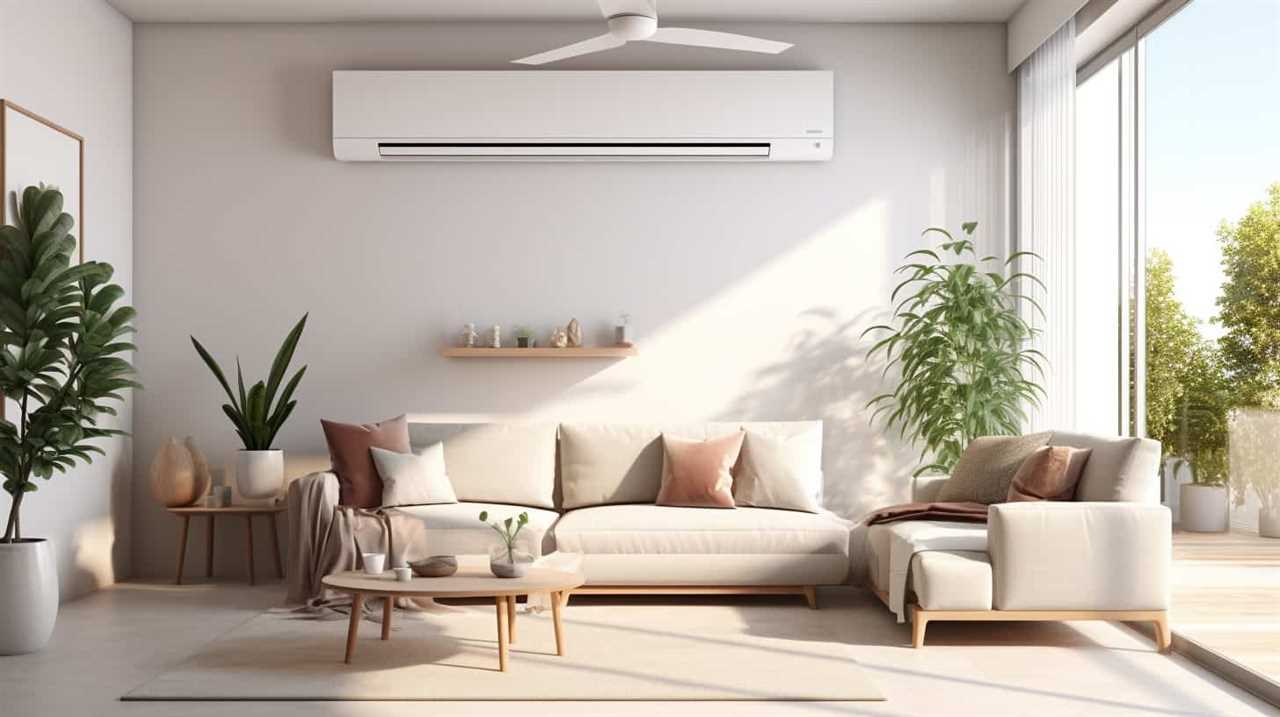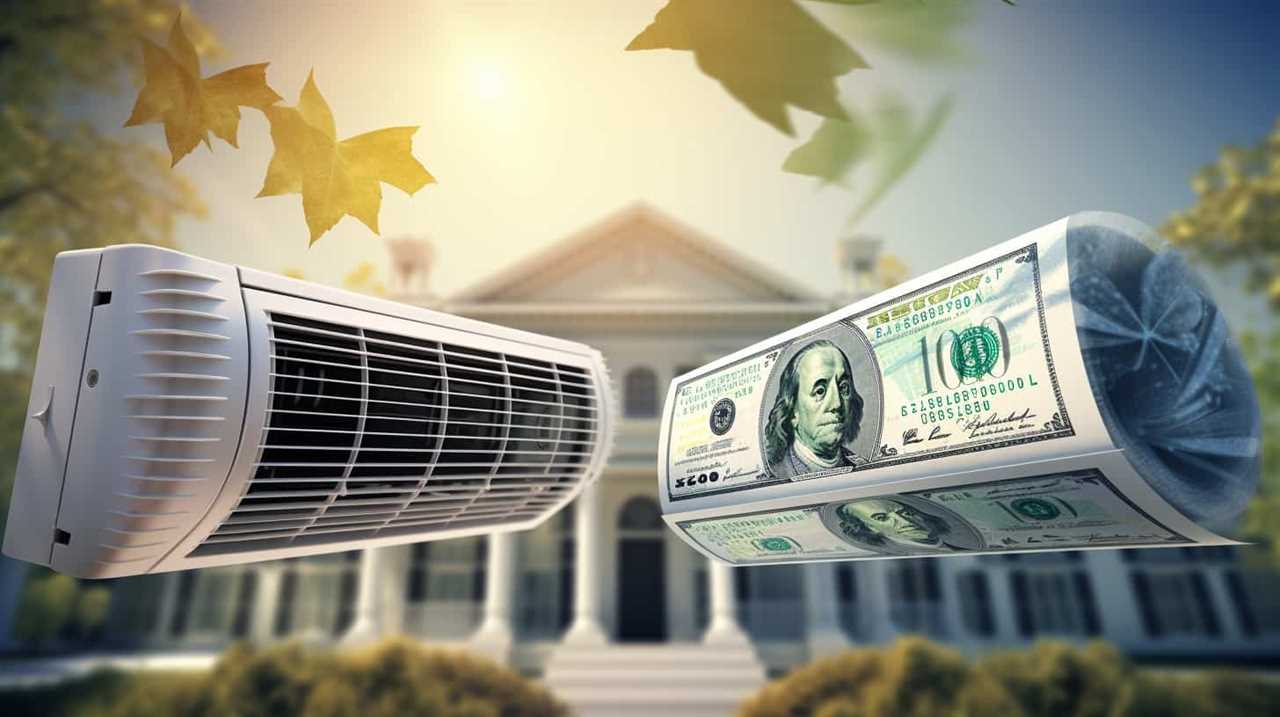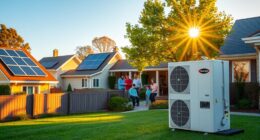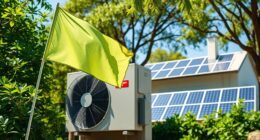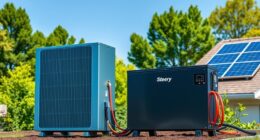We’ve uncovered a revolutionary approach to enhance your comfort while significantly reducing your expenses: energy-efficient heat pumps. These technological wonders effectively move heat to ensure your home is warm in the winter and pleasantly cool in the summer.
With our comprehensive guide, you’ll uncover the secrets behind these efficient machines. Learn how to choose the perfect size, master installation techniques, and unlock the benefits of regular maintenance.
Join us on this energy-saving journey and experience the unparalleled comfort and savings of energy-efficient heat pumps.
Key Takeaways
- Energy-efficient heat pumps reduce energy costs and lower utility bills.
- They are environmentally friendly, consuming less electricity and reducing carbon emissions.
- Properly sizing the heat pump maximizes performance and meets the heating and cooling demands of the home.
- Implementing energy-saving installation tips reduces heat pump energy consumption and saves on energy bills.
The Basics of Energy-Efficient Heat Pumps
Let’s start by understanding the basics of energy-efficient heat pumps.
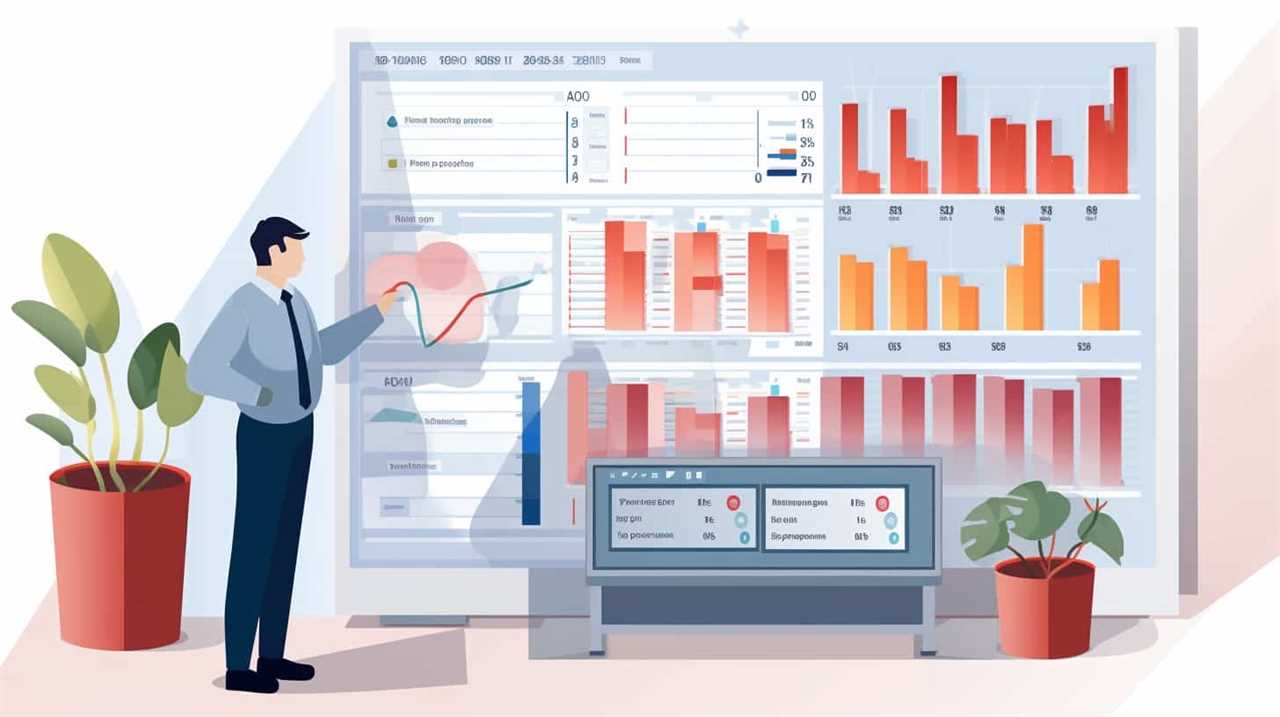
Heat pumps are devices that use electricity to transfer heat from a cool space to a warm space, making the cool space cooler and the warm space warmer.
Heat pump efficiency refers to the amount of heat energy generated compared to the amount of electricity used. Energy-efficient heat pumps have a high efficiency rating, meaning they produce more heat energy while consuming less electricity.
This has several benefits.
Firstly, energy efficient heat pumps can significantly reduce energy costs, resulting in lower utility bills.
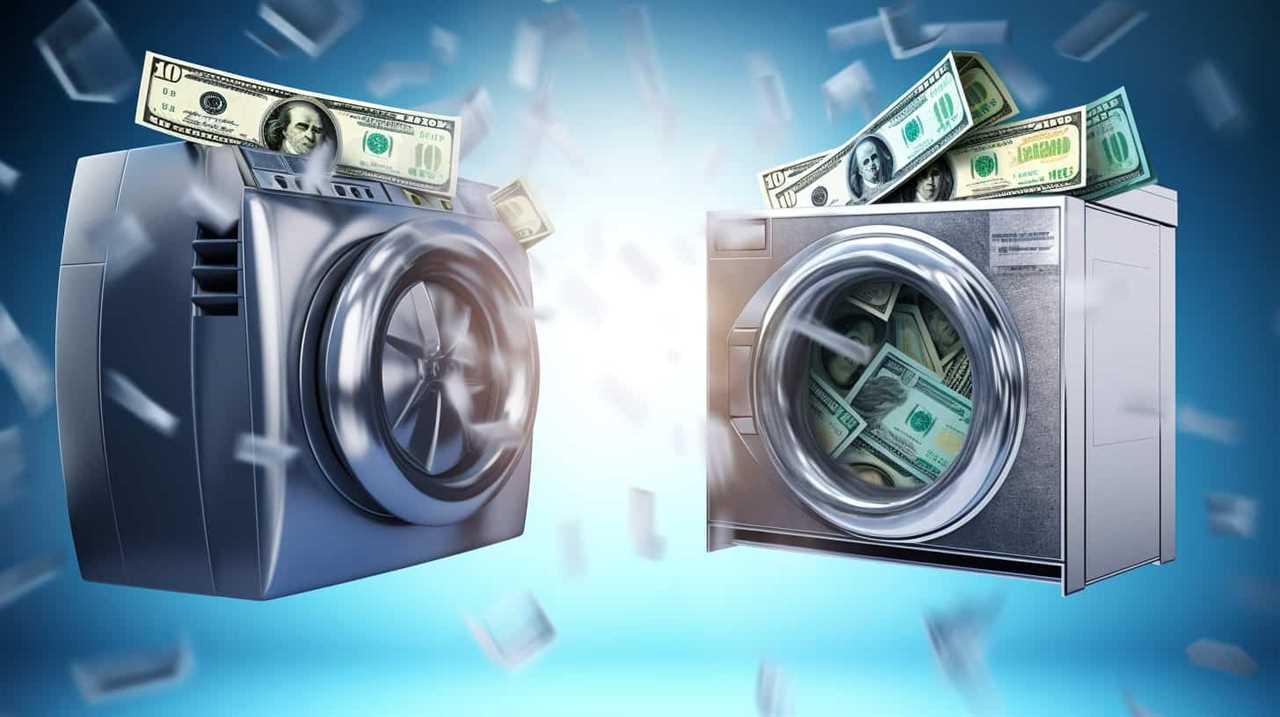
Secondly, they’re environmentally friendly, as they consume less electricity and reduce carbon emissions.
Lastly, they provide consistent and comfortable heating and cooling, ensuring a comfortable indoor environment all year round.
Understanding heat pump efficiency and the benefits of energy-efficient heat pumps is crucial for serving others by providing cost-effective and sustainable heating and cooling solutions.
Understanding the Efficiency Rating of Heat Pumps
To fully understand the efficiency rating of heat pumps, we need to consider the ratio of heat output to electricity input. This rating is commonly referred to as the coefficient of performance (COP). The COP is calculated by dividing the heat output by the electricity input. A higher COP indicates a more efficient heat pump.

When comparing efficiency ratings, it’s important to consider the specific conditions under which the ratings were obtained, as different manufacturers may use different testing methods. Additionally, it’s crucial to note that the efficiency of a heat pump can vary depending on factors such as outdoor temperature and the desired indoor temperature.
To maximize energy savings, it’s recommended to properly size and maintain the heat pump, as well as implement energy-saving tips such as insulating the home and adjusting thermostat settings.
How to Choose the Right Size Heat Pump for Your Home
When selecting the right size heat pump for our home, it’s important to consider factors such as the square footage, insulation levels, and climate conditions. Heat pump sizing is crucial to ensure optimal comfort and energy efficiency.
To calculate the capacity needed, professionals use a formula that takes into account the square footage of the space, the desired temperature difference, and the insulation levels of the home. It’s essential to get an accurate estimate to prevent under or over-sizing, as this can lead to inefficient operation and increased energy consumption.

By properly sizing the heat pump, we can maximize its performance and ensure that it meets the heating and cooling demands of our home.
Now that we understand the importance of choosing the right size, let’s explore how to maximize efficiency with proper heat pump installation.
Maximizing Efficiency With Proper Heat Pump Installation
When it comes to maximizing efficiency with proper heat pump installation, there are several important points to consider.
Optimal installation techniques, such as ensuring proper ductwork and insulation, are crucial for achieving energy savings.

Additionally, following energy-saving installation tips, such as locating the outdoor unit in a shaded area and sealing any air leaks, can further enhance the efficiency of the heat pump system.
Optimal Installation Techniques
We will discuss three optimal installation techniques to maximize efficiency when installing heat pumps. Efficient installation methods are crucial for improving heat pump performance and ensuring optimal energy savings.
Firstly, proper sizing is essential. It’s important to accurately determine the heating and cooling requirements of the space to ensure the heat pump is appropriately sized. An undersized heat pump will struggle to meet the demand, leading to decreased efficiency and increased energy consumption. Conversely, an oversized heat pump may short cycle, leading to inefficient operation and reduced comfort.
Secondly, correct placement of the outdoor unit is crucial. The unit should be installed in a well-ventilated area away from obstructions such as walls or vegetation. This allows for proper air circulation and prevents airflow restrictions, maximizing heat pump performance.

Lastly, ensuring proper refrigerant charge is essential. An improper refrigerant charge can significantly impact the efficiency of the heat pump. It’s crucial to follow manufacturer guidelines and industry standards to achieve the correct charge, optimizing performance and energy efficiency.
Energy-Saving Installation Tips
Our installation tips focus on maximizing efficiency with proper heat pump installation. By following these guidelines, you can reduce heat pump energy consumption and save on your energy bills:
- Set energy-saving thermostat settings to optimize comfort and efficiency.
- Ensure proper insulation in your home to minimize heat loss.
- Seal any air leaks in windows, doors, and ductwork to prevent energy waste.
- Regularly clean and maintain your heat pump to keep it running efficiently.
Implementing these energy-saving installation tips won’t only help you lower your energy bills but also contribute to a more sustainable and environmentally friendly home.
However, it’s important to remember that proper installation is just the first step in maintaining energy efficiency. Regular maintenance is also crucial to ensure your heat pump continues to operate at maximum efficiency.
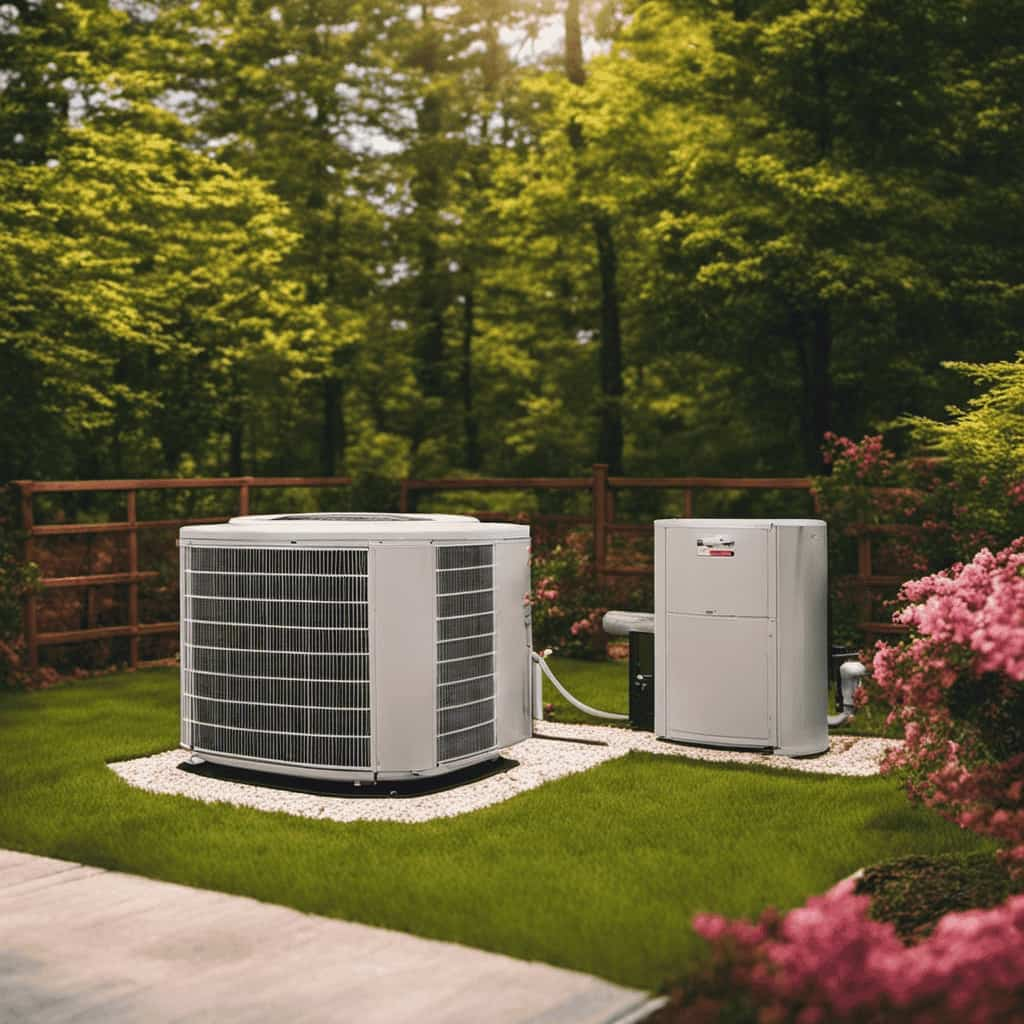
The Benefits of Regular Maintenance for Energy-Efficient Heat Pumps
Regularly maintaining energy-efficient heat pumps can help us maximize their performance and extend their lifespan. The benefits of professional maintenance for these heat pumps are numerous.
First, it ensures that the system operates at its peak efficiency, reducing energy consumption and lowering utility bills.
Professional technicians can also identify and fix minor issues before they become major problems, preventing costly repairs down the line.
Additionally, regular maintenance helps to maintain indoor air quality by keeping the system clean and free from dust and debris.

As for cost-saving maintenance tips, homeowners can clean or replace air filters regularly, check and clean the outdoor unit, and schedule annual professional maintenance visits.
By following these tips and investing in professional maintenance, we can enjoy the full benefits of our energy-efficient heat pumps.
Now, let’s compare energy-efficient heat pumps to traditional HVAC systems.
Energy-Efficient Heat Pumps Vs. Traditional HVAC Systems
When comparing energy-efficient heat pumps to traditional HVAC systems, there are several key differences to consider.
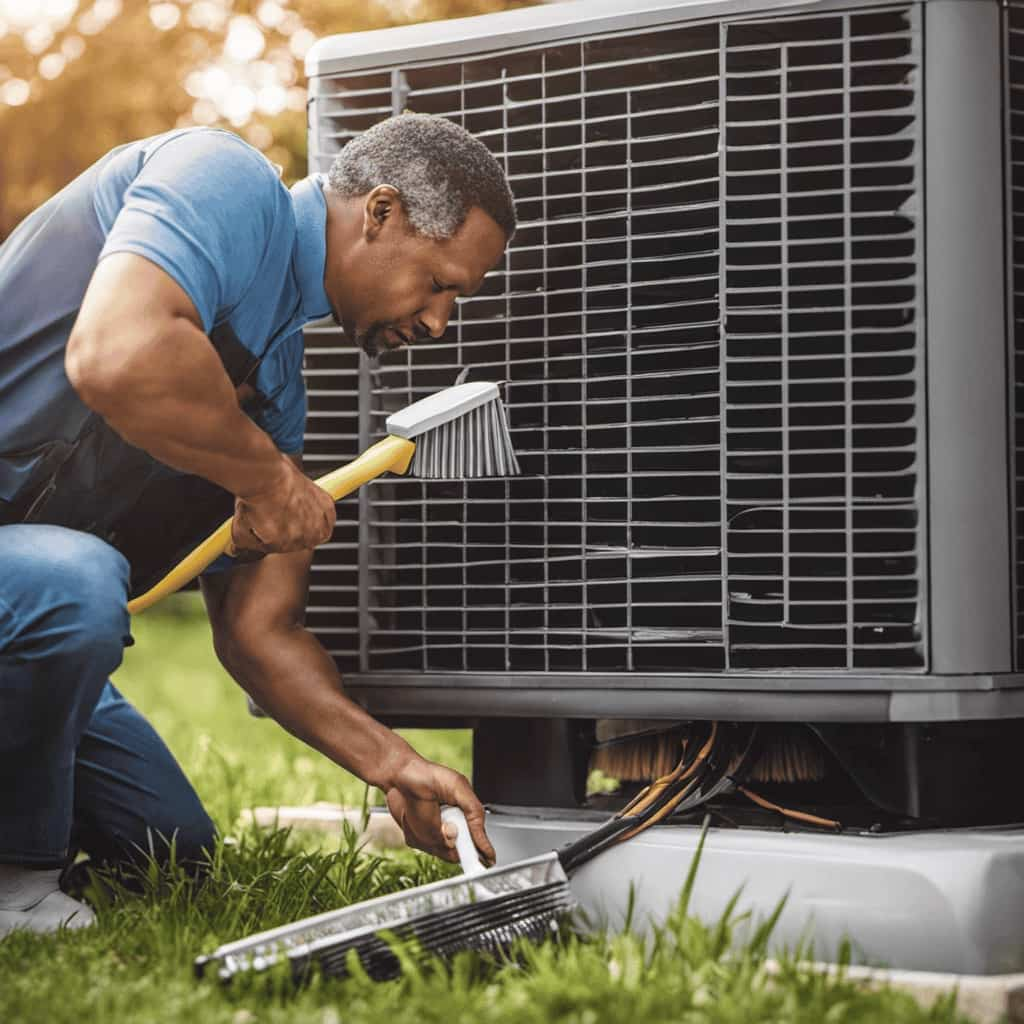
-
Energy Savings: Energy-efficient heat pumps use less electricity to heat or cool a space, resulting in lower energy bills for homeowners. Traditional HVAC systems, on the other hand, can be less efficient and consume more energy, leading to higher costs.
-
Environmental Impact: Energy-efficient heat pumps are designed to be more environmentally friendly, as they produce fewer greenhouse gas emissions compared to traditional HVAC systems. This means that by choosing an energy-efficient heat pump, homeowners can reduce their carbon footprint and contribute to a cleaner and greener environment.
-
Improved Comfort: Energy-efficient heat pumps provide consistent and comfortable heating and cooling throughout the year. They can maintain a constant temperature, adjusting to the needs of the occupants. Traditional HVAC systems may struggle to maintain a consistent temperature, resulting in hot or cold spots in the home.
-
Long-term Savings: While energy-efficient heat pumps may have a higher upfront cost compared to traditional HVAC systems, they offer long-term savings through reduced energy consumption and lower utility bills. Over time, these savings can offset the initial investment, making energy-efficient heat pumps a cost-effective choice.
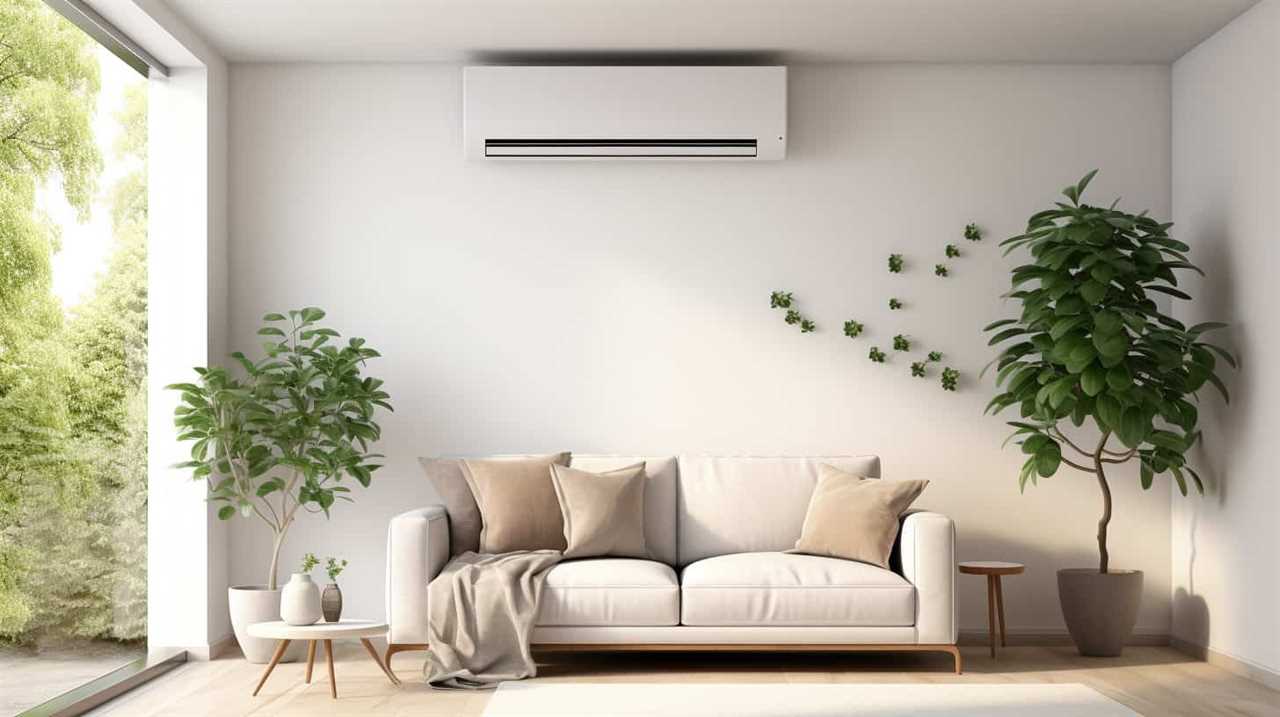
Tips for Optimizing Heat Pump Performance and Energy Savings
When it comes to optimizing heat pump performance and achieving energy savings, there are several important points to consider.
First, adjusting the temperature settings for efficiency can have a significant impact on energy consumption.
Regular maintenance and cleaning of the heat pump is also crucial to ensure optimal performance.
Additionally, investing in insulation and weatherproofing can help prevent heat loss and improve overall energy efficiency.

Temperature Settings for Efficiency
To maximize heat pump performance and save energy, we recommend adjusting the temperature settings based on your comfort needs. Here are some energy-saving tips for temperature control:
-
Set the thermostat to a moderate temperature: Keeping your heat pump at a moderate temperature, around 68°F (20°C) during the winter and 78°F (25°C) during the summer, can help save energy without sacrificing comfort.
-
Use programmable thermostats: Programmable thermostats allow you to set different temperatures for different times of the day, so you can avoid heating or cooling an empty house.
-
Take advantage of natural heating and cooling: Open curtains during the day to let sunlight warm your home, and close them at night to retain heat. In the summer, use blinds or shades to block out the sun’s heat.
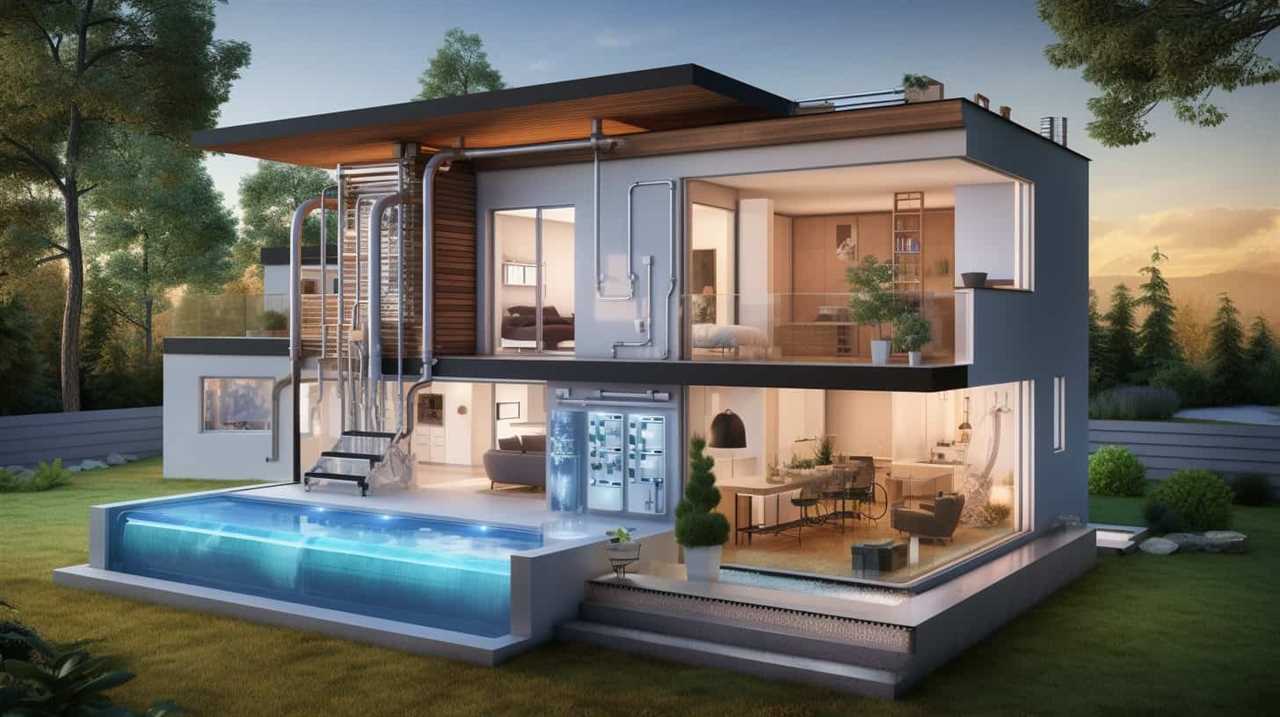
-
Consider zoning systems: Zoning systems allow you to control the temperature in different areas of your home independently, maximizing comfort and energy savings.
Regular Maintenance and Cleaning
We recommend performing regular maintenance and cleaning on your heat pump to ensure optimal performance and energy savings.
Regular maintenance includes inspecting and cleaning the air filters every one to three months. Dirty filters can restrict airflow and decrease efficiency.
It’s also important to clean the outdoor unit regularly by removing any debris, such as leaves or grass clippings, that may obstruct airflow. Additionally, check the fins on the outdoor unit for any signs of damage and straighten them if necessary.

Cleaning techniques for the indoor unit include wiping down the evaporator coils with a soft cloth and cleaning the condensate drain to prevent clogs.
Insulation and Weatherproofing
Our insulation and weatherproofing measures will help optimize heat pump performance and energy savings. By implementing effective insulation techniques and using high-quality weatherproofing materials, we can ensure that your heat pump operates at its highest efficiency.
Here are some key measures to consider:
- Insulate your walls, floors, and ceilings to minimize heat loss and gain.
- Seal any air leaks around windows, doors, and electrical outlets to prevent drafts.
- Use weatherstripping and caulking to seal gaps in windows and doors.
- Install insulation around your heat pump system to reduce heat transfer.
These measures work together to create a well-insulated and weatherproofed environment, allowing your heat pump to operate optimally and saving you energy and money.
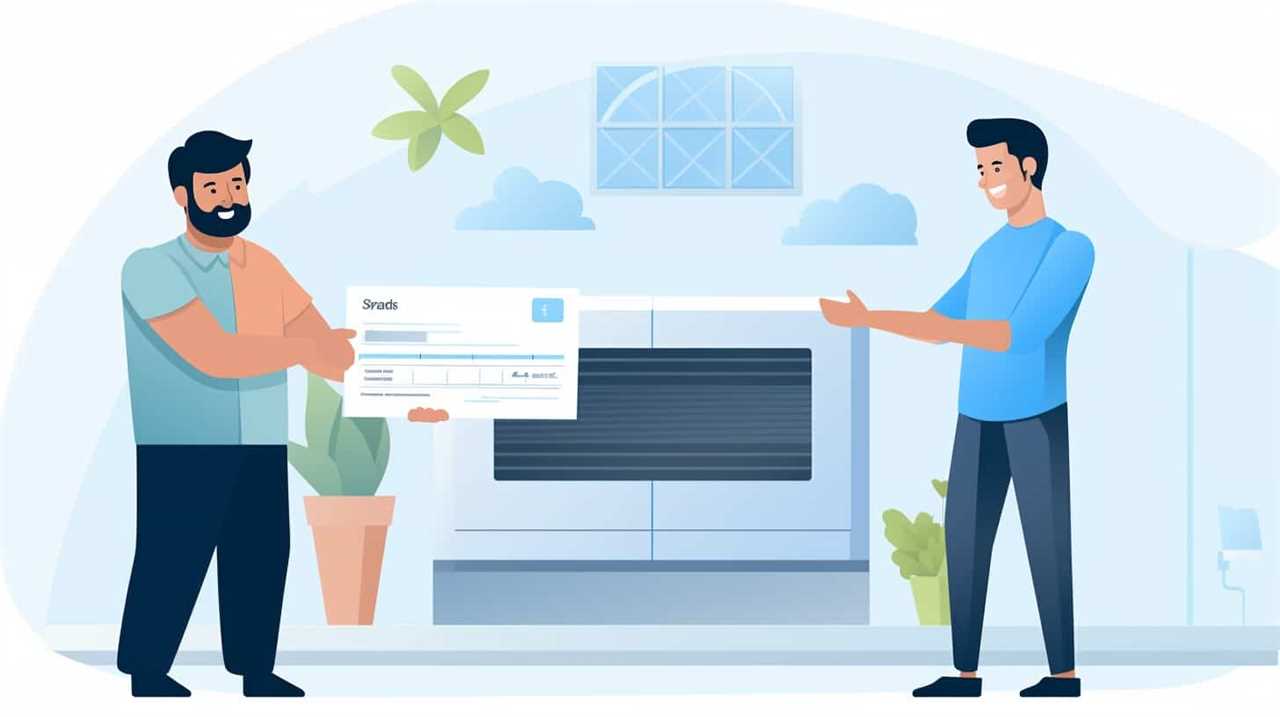
Exploring Advanced Features of Energy-Efficient Heat Pumps
Advanced features of energy-efficient heat pumps can significantly enhance the comfort and efficiency of our home heating and cooling system. These advanced control features allow for precise temperature control, ensuring that our home is always at the perfect temperature.
With smart home integration, we can conveniently control our heat pump remotely through our smartphones or other smart devices. This means we can adjust the temperature, set schedules, and monitor energy usage even when we’re not at home.
Additionally, some heat pumps come with advanced sensors and algorithms that can detect occupancy and adjust the heating or cooling accordingly, optimizing energy efficiency. These features not only provide us with greater control and convenience but also help to further reduce our energy consumption and lower our bills.
Now, let’s address some common myths and misconceptions about energy-efficient heat pumps.
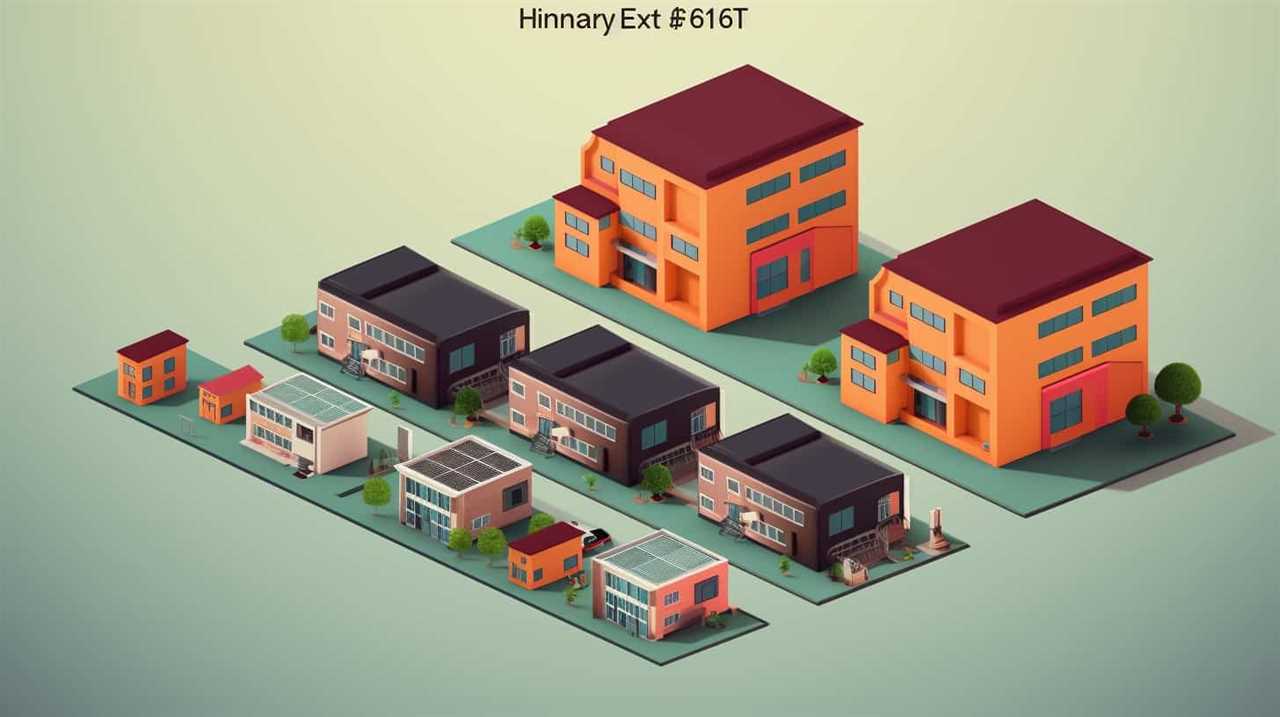
Common Myths and Misconceptions About Energy-Efficient Heat Pumps
Are there any common myths and misconceptions about energy-efficient heat pumps?
Let’s address some of the most prevalent ones and provide accurate information to dispel these misconceptions.
-
Myth 1: Heat pumps are only effective in warm climates.
-
Myth 2: Heat pumps aren’t suitable for cold climates.
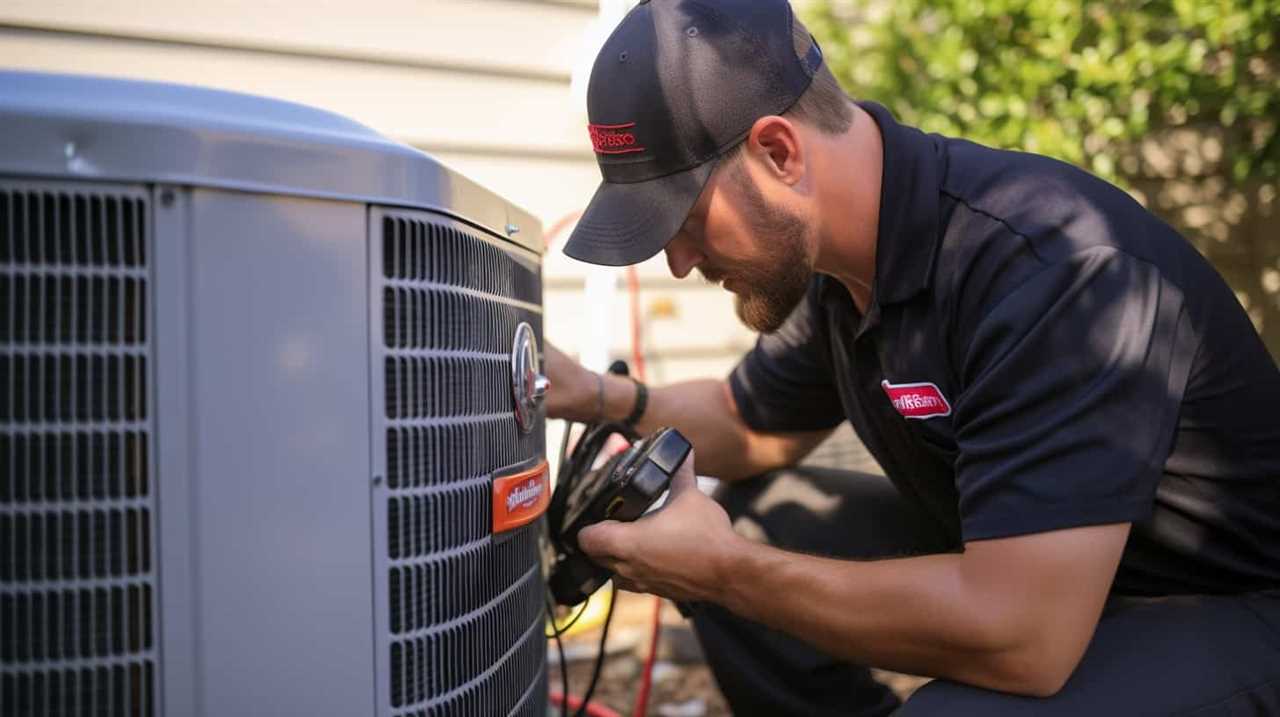
-
Myth 3: Heat pumps are expensive to install and maintain.
-
Myth 4: Heat pumps consume more energy than traditional heating systems.
In reality, energy-efficient heat pumps are versatile and can operate effectively in both warm and cold climates. They can extract heat from the air, ground, or water sources, making them suitable for various regions.
While the initial installation cost may be higher than traditional systems, the long-term energy savings can offset this expense. Additionally, modern heat pumps have advanced technology that ensures energy efficiency, resulting in lower utility bills.

Government Incentives and Rebates for Energy-Efficient Heat Pumps
When it comes to energy-efficient heat pumps, government incentives and rebates can provide significant financial benefits.
These incentives are designed to encourage homeowners to upgrade their heating systems to more energy-efficient options, helping to reduce energy consumption and lower utility bills.
However, it’s important to note that eligibility criteria may vary, so it’s crucial to research and understand the specific requirements to take advantage of these incentives and rebates.
Financial Benefits of Incentives
We can save money by taking advantage of government incentives and rebates for energy-efficient heat pumps. Here are some financial benefits that come with these incentives:

- Financial savings: By installing an energy-efficient heat pump, you can significantly reduce your monthly energy bills. These heat pumps are designed to consume less energy while still providing efficient heating and cooling.
- Return on investment: Investing in an energy-efficient heat pump can provide long-term financial benefits. The initial cost of the heat pump may be higher, but the energy savings over time can help you recoup your investment.
Government incentives: Many governments offer incentives and rebates to encourage the adoption of energy-efficient technologies. These incentives can help offset the cost of purchasing and installing an energy-efficient heat pump.
- Environmental impact: By opting for an energy-efficient heat pump, you’re not only benefiting financially but also contributing to a greener future by reducing your carbon footprint.
Taking advantage of these incentives can help make energy-efficient heat pumps more affordable and provide a positive impact on both your finances and the environment.
Eligibility Criteria for Rebates
To determine if you qualify for government incentives and rebates for energy-efficient heat pumps, it’s essential to review the eligibility criteria. These criteria vary depending on your location and the specific program you’re applying for. However, here are some common requirements to consider before submitting your rebate application:
-
Energy Star Certification: Most rebate programs require the heat pump to be Energy Star-certified, ensuring its energy efficiency.
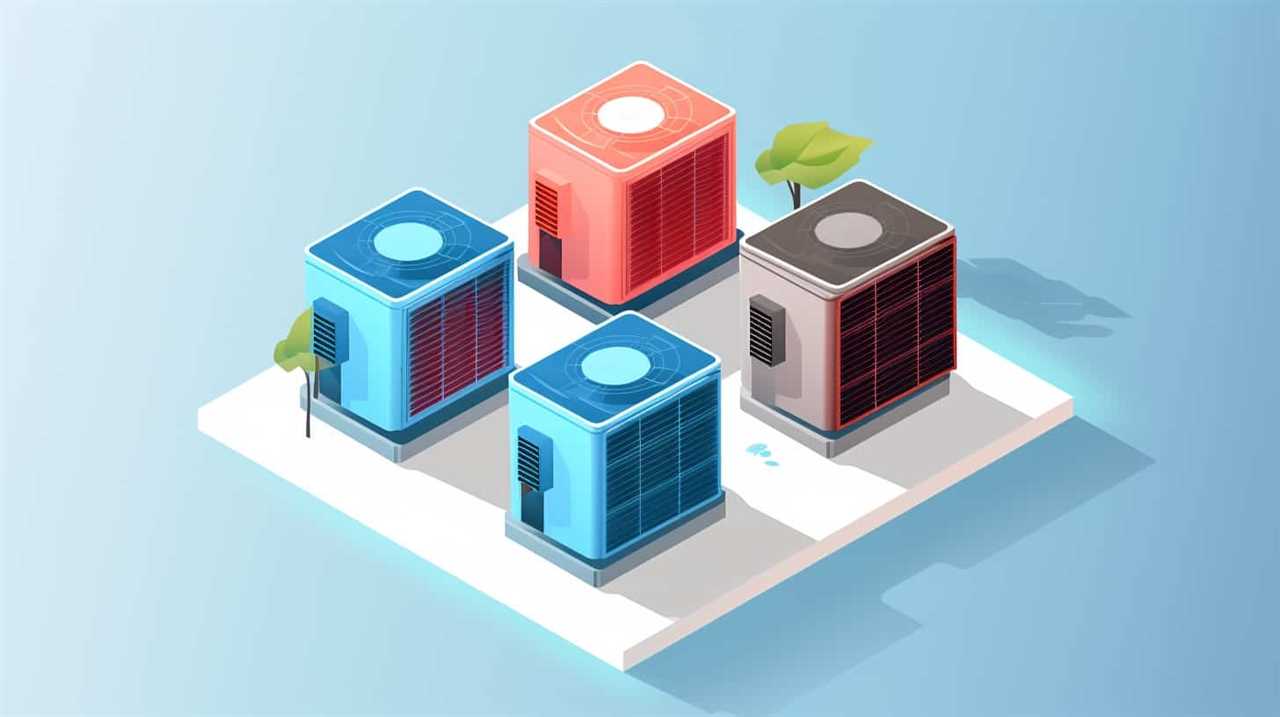
-
Professional Installation: The heat pump should be installed by a licensed professional to ensure proper functioning and energy savings.
-
Minimum Efficiency Ratings: Rebate programs often have minimum efficiency requirements, such as Seasonal Energy Efficiency Ratio (SEER) or Heating Seasonal Performance Factor (HSPF) ratings.
-
Rebate Processing: After submitting your rebate application, it will go through a processing period to verify eligibility and ensure all required documentation is provided.
The Future of Energy-Efficient Heat Pump Technology
The future of energy-efficient heat pump technology holds immense potential for revolutionizing the way we heat and cool our homes. As advancements continue to be made, we can expect to see significant improvements in heat pump technology that will have a positive impact on both our comfort and the environment.
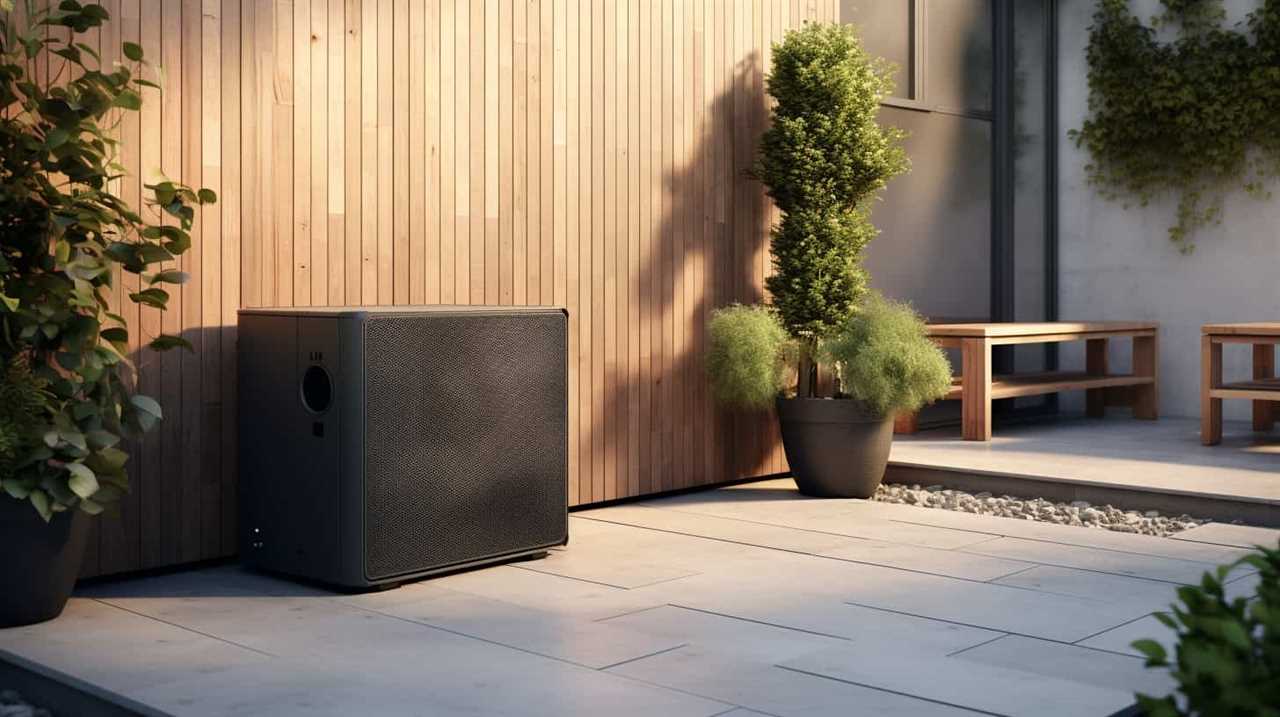
Here are some key developments to look forward to:
- Increased energy efficiency: New heat pump models will be designed to operate even more efficiently, reducing energy consumption and lowering utility bills.
- Enhanced environmental friendliness: Heat pumps will utilize refrigerants with lower global warming potential, minimizing their impact on the environment.
- Smarter control systems: Advanced automation and control features will allow homeowners to optimize their heat pump’s performance and energy usage.
- Integration with renewable energy sources: Heat pumps will be seamlessly integrated with renewable energy systems, such as solar panels, to further reduce reliance on fossil fuels.
With these advancements, the future of energy-efficient heat pump technology promises a greener and more comfortable future for all.
Frequently Asked Questions
How Much Money Can I Expect to Save on My Energy Bills by Using an Energy-Efficient Heat Pump?
We can expect to save a significant amount of money on our energy bills by using an energy-efficient heat pump. The return on investment is high due to the energy savings achieved.
Are There Any Tax Credits or Financial Incentives Available for Installing an Energy-Efficient Heat Pump?
Yes, there are tax credits and financial incentives available for installing energy-efficient heat pumps. These incentives can help offset the cost of the installation and make it more affordable for homeowners like us.
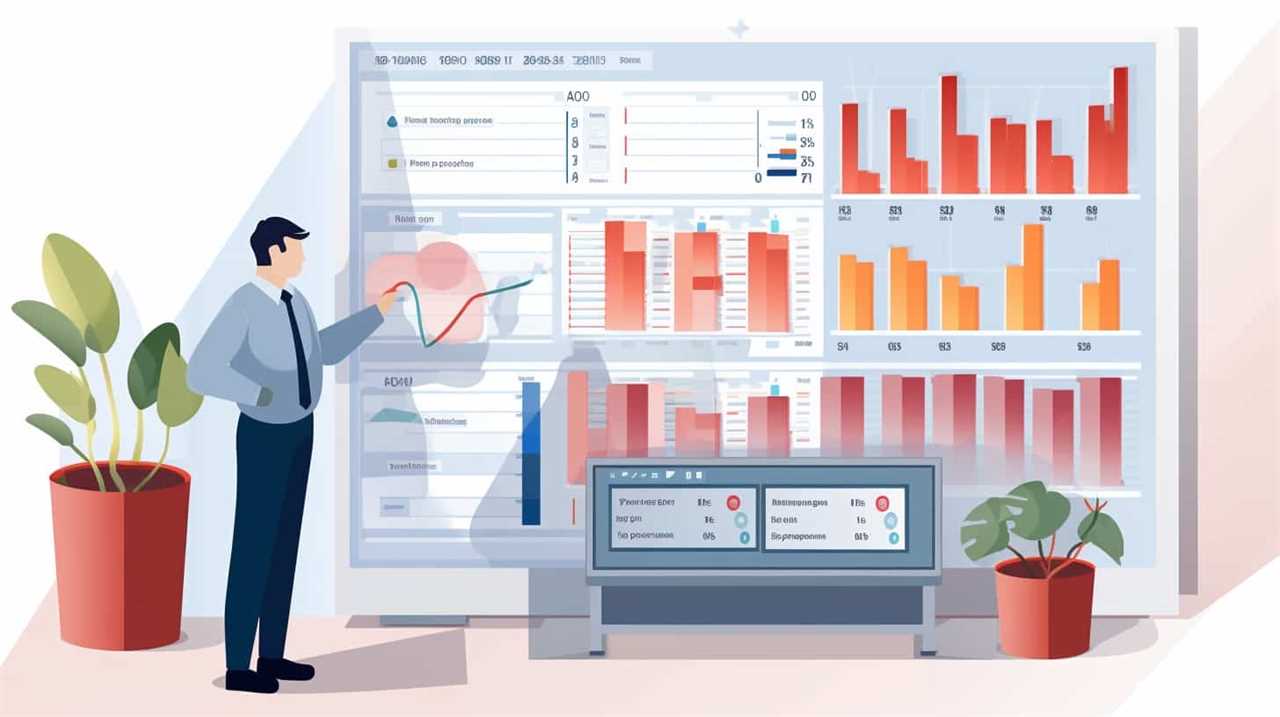
Can I Use an Energy-Efficient Heat Pump in a House With an Existing Ductwork System?
Yes, you can use an energy-efficient heat pump in a house with an existing ductwork system. The installation process involves assessing compatibility and making necessary adjustments to ensure efficient operation and maximum comfort.
How Long Does the Installation Process Typically Take for an Energy-Efficient Heat Pump?
The installation process for energy-efficient heat pumps typically takes a few days. However, the benefits they provide, such as improved comfort and lower energy bills, are worth the wait.
Are There Any Specific Maintenance Tasks That I Need to Perform Regularly to Ensure the Optimal Performance of My Energy-Efficient Heat Pump?
Regular maintenance tasks are essential for ensuring the optimal performance of our energy-efficient heat pumps. By performing tasks such as cleaning or replacing filters, checking refrigerant levels, and inspecting electrical connections, we can maximize efficiency and extend the lifespan of our heat pumps.
Conclusion
In conclusion, energy-efficient heat pumps offer a cost-effective and comfortable solution for heating and cooling homes. By understanding the efficiency rating and choosing the right size heat pump, homeowners can maximize energy savings. Proper installation, regular maintenance, and exploring advanced features further enhance efficiency.
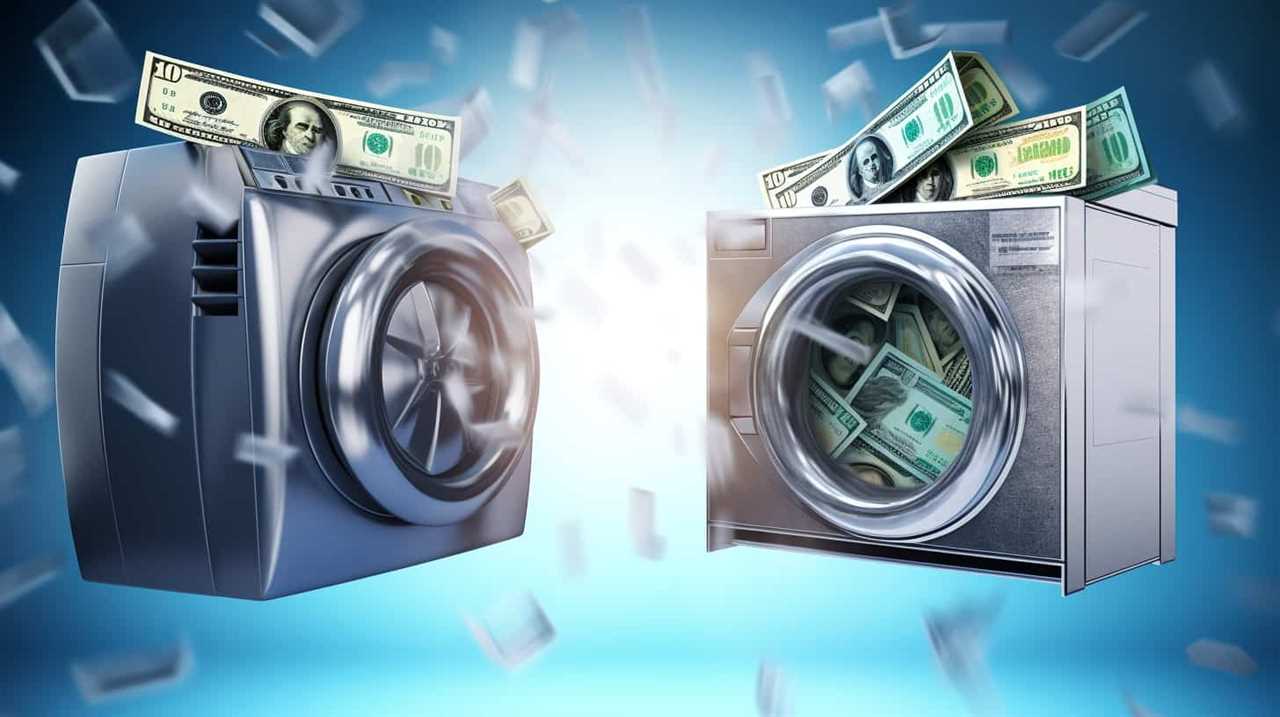
Contrary to common misconceptions, energy-efficient heat pumps are reliable and effective. Additionally, government incentives and rebates make them an even more attractive option.
As technology continues to advance, the future of energy-efficient heat pump technology looks promising.


